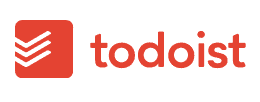Any.Do vs Todoist: Which Is Worth Your Time in 2025
If you are looking for a task management app to manage your personal or work-related tasks, this Any.do vs Todoist review will help you pick the best tool for you. Our project management experts took both apps for a spin and put together their findings in this comprehensive guide.
Key Takeaways: Any.Do vs Todoist
- Both Todoist and Any.do are solid list-based productivity apps that will help you stay more organized when managing your daily tasks.
- The main difference between Any.do and Todoist is that Todoist gives more features on its free version, including multiple templates and some admin controls.
- Any.do and Todoist have team plans, but they can’t compare to the plans of project management software like monday.com, ClickUp or Asana.
Todoist and Any.do are quite similar and effective for task management. Our project management experts compared them and found the main distinction is the features available in the free plan. To learn the details, we created this Any.do vs Todoist guide.
If you’re not clear on which tool to use after reading this comparison, consider checking out the tools highlighted on our best project management tools list. Otherwise, you can also try Any.do for free, as well as try Todoist’s free plan.
-
12/12/2023 Facts checked
Rewritten to include up-to-date information about features, pricing and company news.
- 1
- 2
Our Comparison Guidelines
We compared the features, functions, integrations and pricing of both Any.do and Todoist for this guide. Keep in mind that these are tools for task management not project management.
In this comparison, we focused on the free versions since most of our readers will probably be looking for a productivity app for personal task management. However, we’ll also highlight the key features found in each tool’s team plan. If you want more detailed examination of each service, read our full Todoist review and Any.do review.
Cloudwards Editor’s Choice: Todoist
In our opinion, we found Todoist to be a better choice over Any.do because it offers access to more features on its free plan. For instance, Kanban boards are available on Todoist’s free plan but not on Any.do’s. Also, unlike Any.do, you can manage multiple projects and get more advanced admin options on Todoist’s free version.
However, as good as we think it is, Todoist could do better by adding more color to its user interface. It looks more drab than the majority of productivity apps. It would also be a plus to have dependency management and a built-in calendar on Todoist.
Todoist vs Any.Do: Comparison at a Glance
| Features | ||
|---|---|---|
| $4.99 / month(All Plans) | $4 / month(All Plans) | |
| Review | Review | |
| Kanban board | ||
| List | ||
| Calendar | ||
| Timeline | ||
| Spreadsheet view | ||
| Gantt charts | ||
| Workload planning | ||
| Long-term planning | ||
| Multiple project management | ||
| Dependency management | ||
| Native scrum management | ||
| Set user permissions | ||
| File storage | ||
| Time-tracking | ||
| Built-in integrations | ||
| Reporting features | ||
| Free plan | ||
| Free Trial | 14 days (Teams) | 30 days |
| Web app | ||
| Windows | ||
| MacOS | ||
| Android | ||
| iOS | ||
| AI Tools | ||
| Ticket-based support | ||
| Tutorials | ||
| Knowledgebase | ||
| Forum | ||
| Live chat | ||
| Phone support |
Which Is Better: Any.Do vs Todoist?
Overall, Todoist is the better option as it gives you access to more features on its free version compared to Any.do. The admin options are also more comprehensive on Todoist, making it a better choice for you if you need more than just a simple list to help you get things done.
That being said, Any.do has a more vibrant and visually appealing user interface than Todoist. Any.do was designed to mainly cater to users who need a personal organization and productivity management app. Therefore, it’s the clear winner when all you need is a simple list to organize your personal tasks.
Any.do and Todoist are quite similar when you consider how the apps function. Both are basic lists with bubbles on the left side for marking tasks as completed. Once you click on the bubble, the task is taken off the list and stored in your history. That way, you view only the tasks that need to be completed.
We Recommend Todoist if You Want…
- A list-based app that also offers recurring tasks, Kanban boards and a small calendar view.
- An app with multiple templates and some admin controls on the free plan.
- A task management tool where you can organize multiple projects in one place and plan far into the future.
We Recommend Any.Do if You Want…
- A list to manage and organize simple tasks and plan up to seven days into the future.
- An app to help you manage small teams with simple workloads with minimal dependencies.
- A more colorful interface with multiple themes to customize the UI to your liking.
If You Want to Consider Other Services, Check Out…
If you’re looking for more than what Any.do or Todoist offers, then consider using the free plan of a project management app.
ClickUp has a loaded Free Forever plan with real-time chats, robust team collaboration features, time tracking integration, list, Gantt chart for 60 uses, calendar and spreadsheet views. With this plan, the limit is not on the features you can access but more on how much you can use them. Asana also has a robust free version that gives you access to multiple views.
Another great alternative is Airtable, which has a more comprehensive free version than Any.do or Todoist and is one of the most popular task management apps. Its free version gives you list, spreadsheet, grid, gallery, form and kanban views along with 100 automations monthly. Trello is another simple project management tool that we consider the best free Kanban service.
However, if you’re looking for the best project management tool overall, we recommend monday.com — just know that the software truly shines in the paid plans, and the free version pales to other options in functionality.
- 1
- 2
- 3
- 4
- 5
1. Comparing Features
Any.do vs Todoist are similar when it comes to their basic functionalities. Both are to-do list apps that help you organize your day. They both have an airy design and a minimalistic user interface. This makes it easy to find every button and feature, even while using them on mobile devices.
With Todoist, you can set recurring Todoist tasks, plan as far into the future as you’d like (Any.do is limited to seven days into the future) and manage multiple projects on the Todoist app (Any.do does not offer multiple-project support).
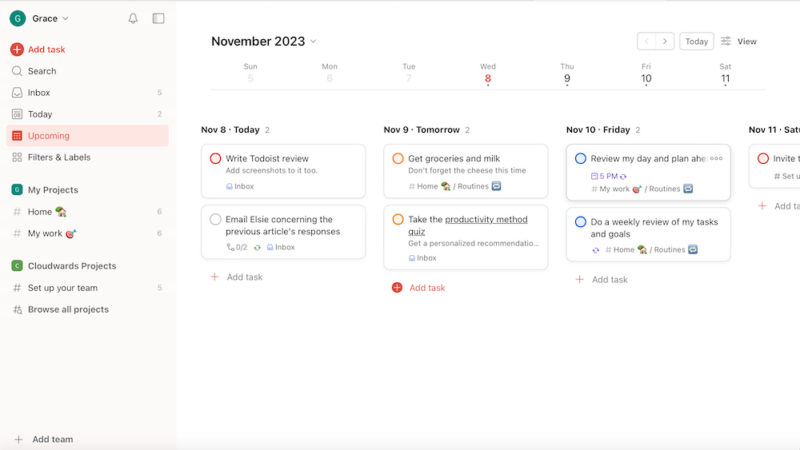
Meanwhile, Any.do has a beautifully designed user interface that’s vibrant and colorful. You can filter your tasks and add over 10 color tags to them. However, you’ll have to upgrade to the paid versions to access Kanban views, WhatsApp reminders and location reminders.
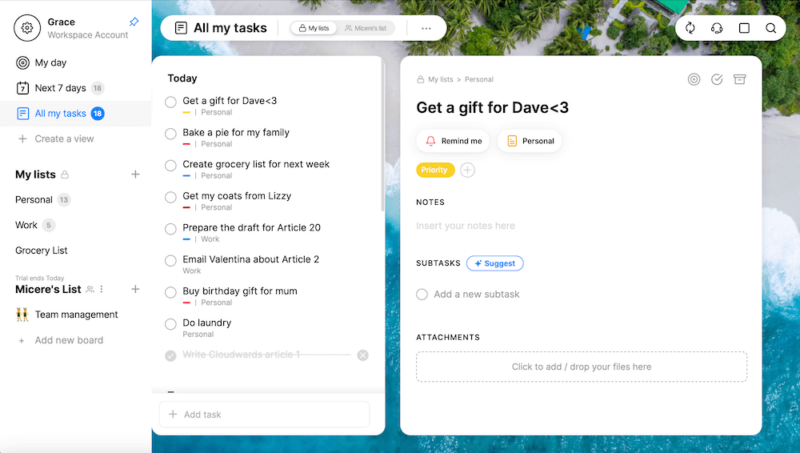
Any.Do Premium Features: Location-Based Reminders, Themes & More
Upgrading to Any.do Premium unlocks a few more features and functionalities, such as location-based reminders and Kanban boards. Location-based reminders send you notifications each time you’re close to the location of a task.
For example, if you often forget to pick up prescriptions from the pharmacy, you can set a mobile location reminder to receive an alert on your phone every time you’re near the pharmacy.
In addition to this, you can access more themes and set recurring tasks on Any.do’s Premium version. This version also lets you create custom themes where you can add your preferred color scheme and get dynamic themes if you’re using an Android device. Before you upgrade to Any.do Premium, keep in mind that Todoist has the majority of these features on its free plan.
Calendars
Any.do recently introduced a built-in calendar to its free and Premium versions. Todoist also has a calendar that shows about a week.
You can also use the Google Calendar integration for Todoist to get an overview of all your upcoming tasks. The integration is easy to set up on both Any.do and Todoist. Both have two-way sync that automatically reflects any changes that you make on the app to Google Calendar and vice versa.
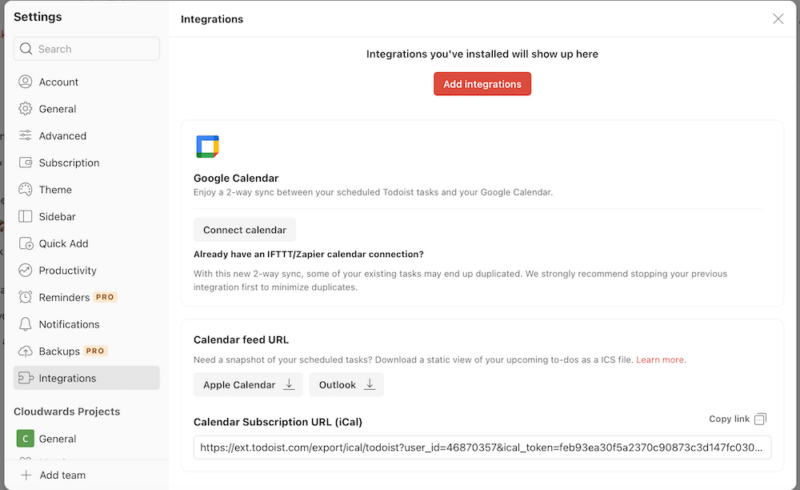
Boards and Integrations
While Any.do offers Kanban boards to only Premium plan users, Todoist includes them on the free plan. Though Todoist’s boards are not very smooth, Any.do’s boards function much better than Todoist’s.
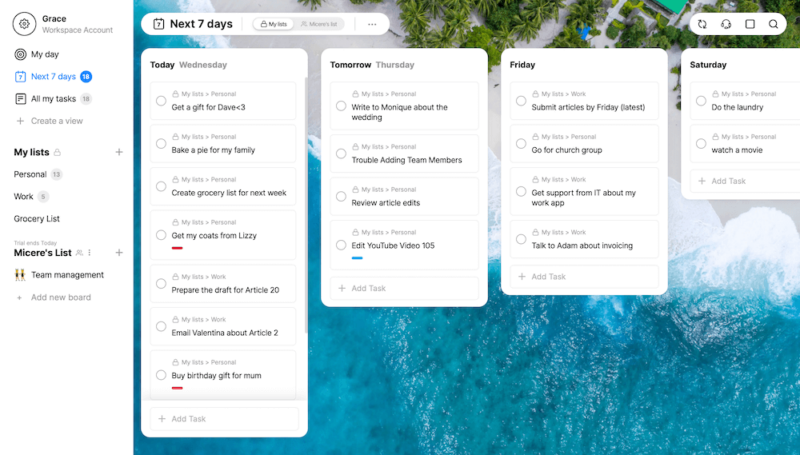
As for integrations, both Todoist and Any.do have multiple integrations with third-party apps, making it easy to access several functionalities that are not built in.
Both apps integrate seamlessly with Zapier, Google Workspace, time-tracking apps, cloud storage services, voice assistants and popular browsers, among others.
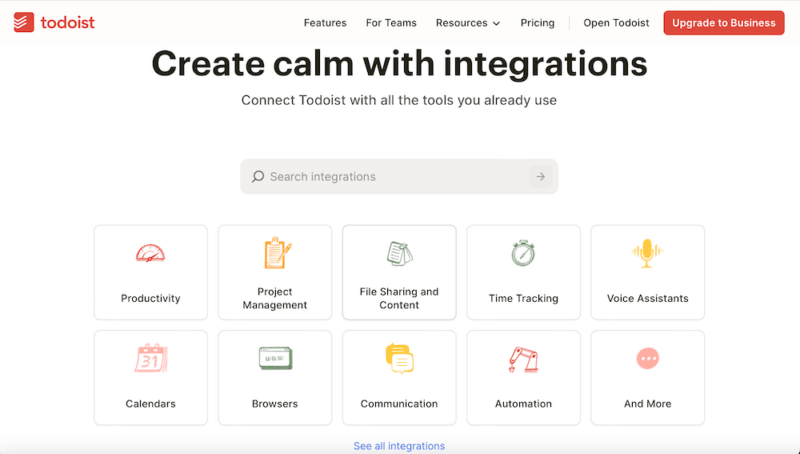
2. Pricing Comparison
Any.do and Todoist both offer free plans, and the paid plans don’t differ too much when it comes to pricing. Any.do Premium goes for $4.99 per month annually while Todoist Pro goes for $4 per month annually. The main difference between them is that the upgrades unlock very different features.
Free Versions
The free versions of Any.do and Todoist function pretty much the same, except that Todoist offers more features on it than Any.do does. You get Kanban boards, more admin control and a small calendar on Todoist, which makes it more than a simple to-do list.
However, if all you want is a simple list that lets you plan seven days ahead, is easy to use, pleasing to the eyes and just enough for you, then Any.do might be the better fit for you.
Todoist Pricing & Features
Todoist has a Pro plan and a Business plan in addition to its free Beginner plan. The Pro plan costs $4 monthly on the annual plan. It gives you access to 300 personal projects, 150 filter views, unlimited activity history, task reminders, automatic backups and an AI assistant.
The Business plan costs $6 monthly on the annual plan. It gives you 500 team projects, a shared team workspace, team roles and permissions, restricted projects and unlimited team members and guests.
- 1 main user 5 active projects 5 collaborators (per project) 5MB file uploads
- 1 main user 300 active projects 25 collaborators (per project) 100MB file uploads
- Multiple users, (price is per user) 500 active projects (per member) 50 people (per project)
Any.do Pricing & Features
Any.do has a Premium plan and a Teams plan, in addition to the free plan. Any.do’s paid versions seem geared toward personal use. The Premium plan costs $4.99 monthly on the annual plan. It gives you access to recurring tasks, WhatsApp reminders, mobile location reminders, color tags and over 5,000 integrations.
Non-business users will find the Premium version a handy tool for productivity management. You can color-tag tasks, as well as set recurring tasks, mobile location and WhatsApp reminders.
The Teams version costs $4.99 monthly. It gives you access to a collaborative workspace, over 100 workflow templates, advanced admin controls, unlimited projects and unlimited team members.
- Tasks & lists Reminders Calendar Daily planner Sync across devices
- Everything in Personal, plus Recurring tasks Whatsapp reminders AI-Powered features Color tags Location reminders
- Everything in Premium, plus Shared family space Up to 4 members included Shared grocery list Shared projects (up to 4)
- Everything in Premium, plus Collaborative workspace Unlimited project boards Unlimited team members +100 workflow templates Admin tools & permissions
3. User-Friendliness
Any.do wins the user-friendliness contest against Todoist, hands down. You get to choose between several colorful themes, including a mountainous landscape, a jungle, a beach, a cityscape and more, according to your preference.
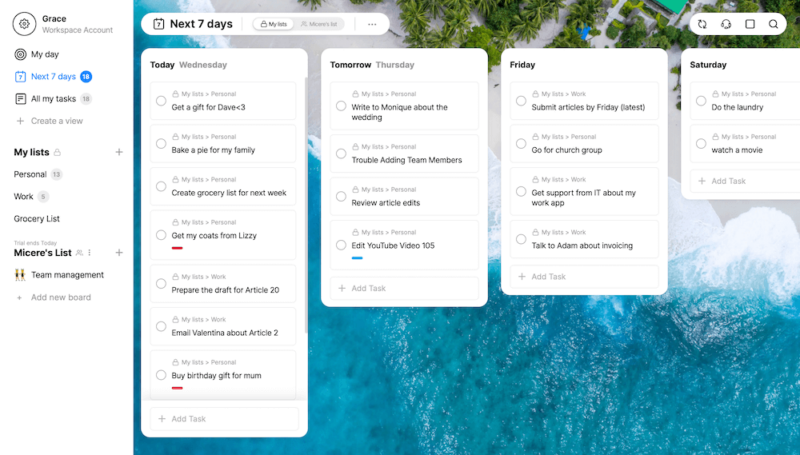
Don’t get us wrong, Todoist isn’t too bad in terms of aesthetics. It’s just that the app doesn’t make much effort to enhance the user experience. It gets the job done, and that is it. There are a few themes you can pick on Todoist, but these will bring only slight color changes to the layout.
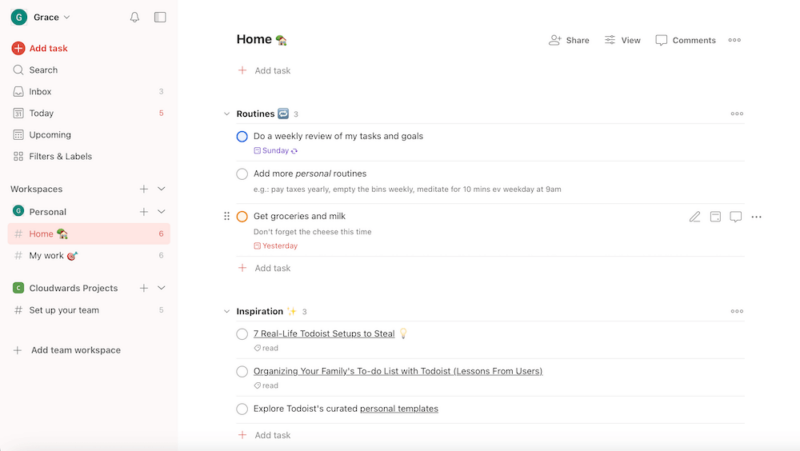
Task Details
We found it easy to create and manage tasks on both Todoist and Any.do:
- Click the “+” button to create a task.
- Give it a title.
- Add a task description along with any details, and that’s it.
You can also add priority levels, color tags and comments on each task without a struggle.
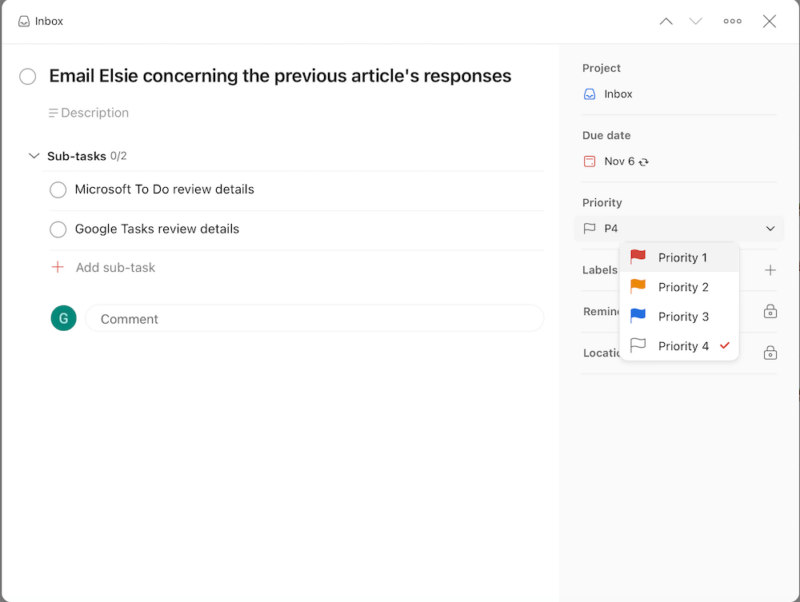
The sidebar on both apps has all the tools you need to effectively manage your tasks. Everything is there, from changing settings to viewing all your lists and upcoming tasks. This makes it easy to find what you need and make changes to your lists with just a few clicks.
Mobile Apps
The mobile apps for both Any.do and Todoist give you all the functions and features available on their desktop apps. Their minimalist designs make them easy to use on mobile devices with small screens.
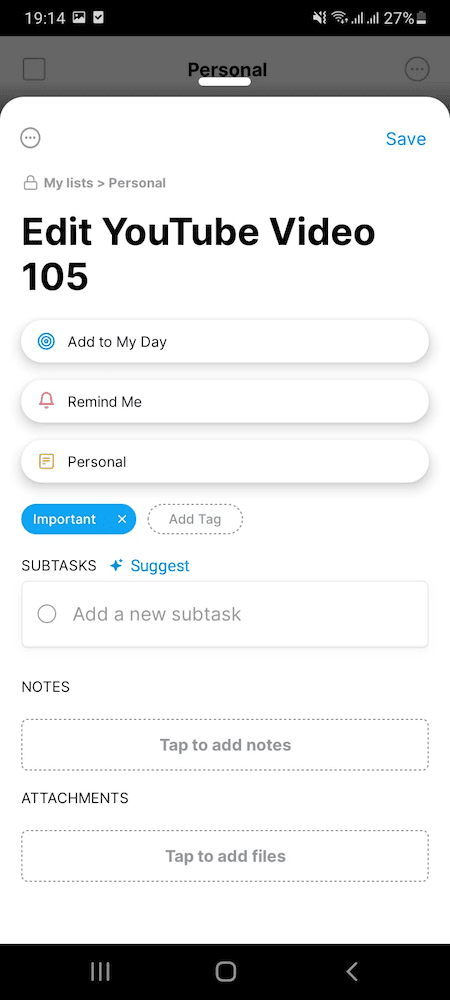
Any.do’s mobile apps are smoother to use and more vibrant than Todoist’s. This shows that Any.do has chosen to focus on personal productivity, even on the go. Other than that, both tools work well on both iOS and Android devices. The Android and iOS apps are similar and function the same.
4. Customer Support
Any.do and Todoist both have well-designed help centers with several articles to help you get started. They also have FAQ sections for you to get help with basic questions about the apps. In addition to this, Any.do has a “super users” forum (which Todoist lacks) that’s mainly for beta testing.
Since Todoist and Any.do are straightforward to use, you may not need to contact support in the first place. In case you do, both apps have an effective ticketing system. We sent a ticket to Todoist support and got a response within only a few hours. Any.do has a ticketing system, but it took 48 hours for us to receive an email response from Any.do support.
Neither Todoist nor Any.do offer chatbot or phone support options. This is unfortunate because these options help expedite the process of getting help.
5. Security & Privacy
Both apps store your data on AWS servers and encrypt it using Transport Layer Security (TLS) when in transit. Todoist goes a step further to encrypt your data using AES 256-bit when it is at rest. The single sign-on option lets you sign in to Todoist and Any.do using your email address, Google profile, Apple ID or Facebook account. That way, you don’t have to create or remember any new passwords.
We found Any.do to have a better privacy policy than Todoist. Todoist’s policy states that the company stores your data and retains the right to determine the retention period unless you manually opt out. This data can be sold to vendors later if the company is sold. Additionally, we found the list of vendors that Todoist shares your data with a bit too long.
Any.do’s privacy policy makes it clear that, though the company collects data to improve service, it will not sell the data unless the company is sold. This gives Any.do the upper hand when it comes to privacy.
The Verdict: Why We Think Todoist Wins Overall
Overall, Todoist wins this battle of the task management apps because it offers access to more features on its free plan; you can manage multiple projects and get more advanced admin options on Todoist’s free version.
However, the decision boils down to how you’ll use the tool. If all you need is a list for personal productivity, then Any.do offers better usability. However, if you need an app that goes beyond lists and helps you manage more than simple tasks, then Todoist could be the better fit.
We recommend you take both free plans for a spin to determine which tool wins the Any.do vs Todoist contest in your books.
Have you tried either Any.do or Todoist? What did you use the app for? Are you seeking an alternative? Let us know in the comments, and thank you for reading.
FAQ: Todoist vs Any.do Compared
The benefits of the Any.do app are its colorful user interface and minimalist design that’s easy to use on desktop and mobile devices.
The main disadvantages of using Todoist are that it doesn’t have a built-in calendar and its Kanban boards are sluggish. It also has a drab user interface that could use a bit more color.
The best to-do list app is a matter of personal preference. We recommend Any.do, Todoist and TickTick for effective list-based task management.
Todoist is among the best task management apps on the market today. However, it’s worth looking at alternatives.




